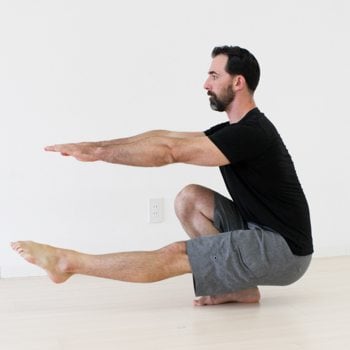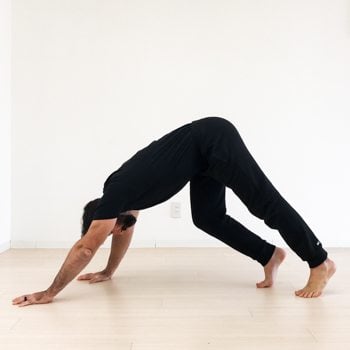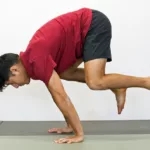“Good form” is a term people throw around a lot without any clear consensus on definition.
 Generally, they are referring to some very detailed and unyielding definition of form for a specific exercise. Like a Platonic Ideal of the exercise in question.
Generally, they are referring to some very detailed and unyielding definition of form for a specific exercise. Like a Platonic Ideal of the exercise in question.
If a person can’t achieve that exact form, then they are automatically exercising with “poor form.”
This type of definition of good form is often more destructive than constructive. It can prevent people from working on skills that they can and should work on, while at the same time coaxing an individual to try to achieve positions that may be unsafe for him or her at that point of their development.
The truth is, good form is difficult to pin down, since the definition changes based on the particular exercise in question, as well as the particular person performing the exercise.
Yet there are certain characteristics that apply to every type of movement and every person. Let’s take a look at what good form actually is.
What is Good Form Anyway?

Here’s a great example from Yuval Ayalon, a master hand balancer who is constantly working on making his handstand prettier.
Good form can look different depending on the individual and the situation–it’s dependent upon the individual’s needs and limitations.
There are two important characteristics of good form that run through all types of movement:
- It must minimize the chances of injury for the individual practicing the movement.
- It must employ efficient body mechanics, to maximize the available strength and energy of the movement.
Here are some other indicators of good form:
A Well-Oiled Machine
When you move with good form, your body works together as a unit, rather than as a collection of parts.
Proper technique is a combination of body stability and mobility in the respective appropriate areas. If everything is “loosey goosey,” your form will fall apart and if everything is rigid, your movement will be unnecessarily restricted.
Mastery of Momentum
Another indicator of good form is the ability to pause with control at any point within the performance of the movement.
Rather than moving with momentum, you move with control, and this is both evidence and a benefit of proper technique. Moving with the intention of control funnels the stresses to the appropriate areas of the body rather than to regions prone to break down and injury.
“I Know It When I See It…”
Often, an untrained observer can tell if someone is performing an exercise with better technique than someone else. It just “looks better,” and the aesthetics of proper form shine through, even to inexperienced eyes.
Just as in dance and other physical performance art, handstand work is judged by proper alignment and the “lines” of the performer. The body angles and steady execution are simply pleasing to the eye.
It can take some time to judge your own form but keep in mind the advice to “make it pretty” and you’ll already be closer to good form.
Good Form Does Not Equal Perfection (’cause there ain’t no such thing anyway)
 There is no one perfect way to move, so “perfect” is a poor aspiration and becomes limiting in all the wrong ways.
There is no one perfect way to move, so “perfect” is a poor aspiration and becomes limiting in all the wrong ways.
Take, for instance, the squat exercise. There are many opinions on how the squat should be performed:
- Some say the feet and knees should be pointed forward
- Others insist they be pointed at an outward angle
- Some argue the back must remain flat throughout the movement
- Others say rounding at the bottom is not a big deal
- Some admonish sitting far back on the heels
- Others tell you to stay on the middle of your foot
You can argue from here until tomorrow about which one is right, but the “correct” form depends on your particular needs and limitations. Any good coach will be able to correct safety errors, while allowing variation for different cases.
Access to cheap and easy video recording is both the best and worst thing to happen to improving form in physical training. It’s wonderful because we can get advice from great coaches all over the world, but on the other, the internet forum “form check” can find you critiqued to death by dubious armchair authorities.
Rather than aiming for perfection, follow key points and guidelines to make sure you’re practicing with safety and efficiency.
There are details in certain exercises, such as in the planche, that shouldn’t be altered: straight and locked out elbows are the very definition of the move. But perhaps you were told that your hands need to be precisely shoulder width apart, or some other specific distance.
Does that rule apply to you if you’ve found better progress with your hands wider or narrower?
When you try to move “perfectly,” it can often hold you back when you may be ready to progress. Good form is absolutely necessary, but you should not wait for perfection as a gauge of when you’re ready to progress.
Instead, use safety and efficiency as your guides. If those key points are happening, you are ready to progress, even if your form isn’t “perfect.”
Three Ways to Improve Your Form
Now that we’ve defined what good form is, how do you put that into practice and make sure you’re training with the best form possible every time?
Here are three strategies that will help you out.
1. Take it down a notch
 Sometimes, you need to take a step back to improve your form.
Sometimes, you need to take a step back to improve your form.
Don’t be afraid to drop down a level of difficulty, decrease your speed, increase your volume, or any variation in between. Breaks in proper technique indicate that you need to scale back a movement.
Continuing to practice with poor technique that doesn’t improve within a few sessions is a big mistake.
Don’t let your ego prevent you from progress!
With the exception of very skilled athletes, most people can’t move fast and well at the same time, so the first thing you should focus on is slowing down your movement.
2. Make deliberate mistakes
 One thing you should recognize is that improving your form will require a period of “high bandwidth”–in other words, you’ll need to allow yourself the freedom to make errors, in order to consolidate your form.
One thing you should recognize is that improving your form will require a period of “high bandwidth”–in other words, you’ll need to allow yourself the freedom to make errors, in order to consolidate your form.
Using exploration and creativity is a great way to work on this.
If you have multiple things to work on when striving for better form, make sure to only focus on one or two new cues at a time, so as not to overwhelm yourself.
3. Establish a baseline of good form
 In the last section I mentioned that a good coach will be able to correct errors while leaving room for necessary variations. But what if you don’t have regular access to a teacher? How can you correct your own errors?
In the last section I mentioned that a good coach will be able to correct errors while leaving room for necessary variations. But what if you don’t have regular access to a teacher? How can you correct your own errors?
First, you need to get a baseline of where you’re at.
One way to do this is to just meet with a good coach when you can to have an outside party gauge your performance.
If that is not an option, you can watch videos to examine the correct technique. This is the method we use in all our programs, and we’ve developed our video tutorial style to make it easy to see precisely which aspects of the technique are most important for good form that promotes skill development.
Supplement this with taking video of yourself to compare your performance to the technique video, and see which areas need improvement. Make adjustments as needed.
As you gain more experience with critiquing your own form, you will become better able to judge how to tweak your form for your needs.
Be Mindful, But Also Be Flexible When Needed
 Good form is critical for improved performance over the long run, as you will be able to make vast improvements to your skill and strength, with less risk of injury.
Good form is critical for improved performance over the long run, as you will be able to make vast improvements to your skill and strength, with less risk of injury.
While it might seem that perfect form is what you are after, searching for perfection is no good if it holds you back.
Have in mind the absolute requirements of proper form, but recognize the need to adjust the details that benefit from a slight deviation. This can be difficult in the beginning of your training, which is why proper instruction from a good coach is an essential starting point.
Your training and form will change as your flexibility, strength, and motor control improve over time, so it’s important to have a flexible mindset as well, and to recognize that working on those aspects of your training will help you out in the long run.
Our introductory program, Elements, is built to help you improve these attributes, while also improving body awareness, so you can better gauge when your form is breaking down and when you’re practicing with good form.
Improve Your Body Awareness
With Elements, you’ll build the strength, flexibility, and body control you need for the activities you love, through assessment and targeted exercises.





